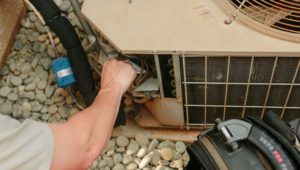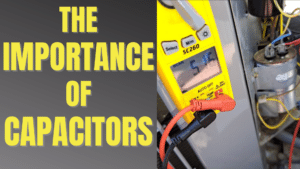Hey HVAC techs! I’m Greg Fox, and today we’re going to talk about diagnosing a bad blower motor. I want to expand on our recent gas furnace troubleshooting series by going into each part of a furnace sequence of operation. This week, it’s the blower motor.
This blog post is all about the commonly used permanent split capacitor (PSC) blower motor. The capacitor is a storage bucket of electrons that helps regulate the voltage going to the motor as it starts up and continues running through the cycle. Today’s capacitors typically last 5 to 10 years. But as always, it can last much longer.
Before you start taking wires off, something I’ve learned over time is:
• I like to use my work phone to take a picture of the wires attached at the control board, so I won’t forget what taps the original wires were attached to. It makes things much easier for me when deciding which color of wires to put where.
• The other thing I do to make things easier for me when I’m disassembling a blower from its housing is to use a marker to identify where the wires were routed as they come from the motor to the control board. This way, you can position the blower and its belly band in the right spot the first time!
Sequence of Operation
So, what needs to happen for the blower fan motor start? In air conditioning or cooling mode, the thermostat calls for the AC to kick on by connecting 24 volts from the R terminal to the Y terminal. But the thermostat also gives 24 volts to the G or Fan terminal. The Y terminal being energized kicks on the outdoor unit, while simultaneously the G terminal being energized turns on the air handler’s blower motor.
In heating mode, the 24 volts at the R terminal connects only to the W terminal to start the sequence of events that happens for the furnace to start up. It energizes the W terminal but NOT the G terminal in heating mode because the control board tells the blower when to turn on. That’s usually 30 to 60 seconds after the flame has ignited to start heating the furnace. The delay in starting it is because we don’t want cold air coming through our ducts while we wait for the heat exchanger to warm up. Smart eh?
Once the low voltage signals have made it to the control board terminals, a series of connections wind themselves through the printed circuit board, where a switch will energize to send 120 volts, or in some cases 240 volts on to the motor. Check your wiring diagram to be sure which motor you have.
Eight things that you can do to diagnose a furnace bad blower motor:
1. Make sure it’s getting power to it – if you don’t have the proper voltage coming in from the board, start by checking voltage at the outlet, then move on to the transformer, making sure high voltage is coming in, and 24 volts is going out to the board.
If you have power to the board and no power is going out to the motor (and everything else is operating normally in the furnace sequence) you may have a bad control board. You can test this by jumping out 120 volts to the blower motor wires; this will let you know if the blower motor works or not.
2. Ensure the capacitor attached to it is good – whether you do it before you jump out the blower motor or not, quickly check the capacitor to see if it meets manufacturer specs. If it doesn’t, replace it and retest.
3. Make sure the motor isn’t getting too warm to the touch – Some motors just get old and dirty. If the blower gets too hot, it can lock up and stop spinning or still spin but have an open winding inside the motor that doesn’t allow the circuit to be complete.
4. Check the amp draws and compare them to the data provided by the furnace sticker. It’s sometimes necessary to use a mirror or pull the motor out to check the motor’s amp rating. If you have access to it, the furnace’s service facts manual will list the OEM motor specs. And they vary quite a bit. 4 to 12 depending on the size of the furnace and type of motor. If the amp draws are too high, either the motor could be going bad, causing intermittent operation, or the static pressure pushing back on the blower squirrel cage is so great it’s causing the motor to strain to provide the air needed.
5. The motor won’t spin – If the rotor that holds the fan blower wheel won’t spin or is hard to spin, it’s a good sign that the blower motor is shot. Once again, if the motor is getting proper voltage and the capacitor is good, but the blower won’t freely spin, it may have seized, which is not uncommon.
6. The motor spins but is making a scraping or screeching noise – You could have proper voltage to the motor, but it has this god-awful screeching noise. Check to make sure the squirrel cage isn’t rubbing against the side of the blower housing. Center the wheel inside the blower housing and re-tighten the locking nut to the rotor shaft, so it doesn’t slide anymore.
7. The spine of the blower wheel could be separated from its fins, which cup the air and throw it into the ducts. The air pushing back against it will cause metal on metal friction, creating the noise. The spine attached to the rotor shaft is spinning much faster than the separated wheel itself. Replace the blower wheel and retest.
8. Dirty blower motors and the importance of filters – I’ve seen blower wheels get so dirty that you need to clean them just to get air moving again. The cups are filled with so much dust, dirt, skin, and hair that it weighs down the wheel and creates a motor strain. Sometimes when it’s bad like this (and you should tell your customer this before you perform the blower cleaning), the clean wheel becomes light enough again that the motor burns itself out because all this time, it’s been used to spinning a heavier weight.
You could clean everything and get it going again, and two weeks later, get called out because the blower’s not working because it spun out. If you covered your bases by communicating properly with the customer, your company wouldn’t have to pay for a new blower motor. It could look shady if you didn’t—just something to think about.
I hope this blog post has given you some useful pointers to use out in the field. Pinpointing a bad blower motor can be one of the more intimidating parts of diagnosing a furnace. But if you know when it’s supposed to turn on in the sequence of operation, you can go from there by checking the things listed in this post.
Thanks so much for stopping by, and we’ll see you at the next blog post.




















